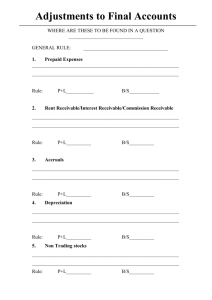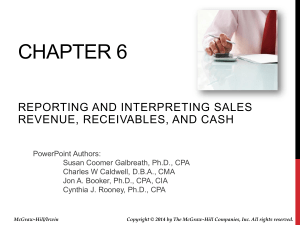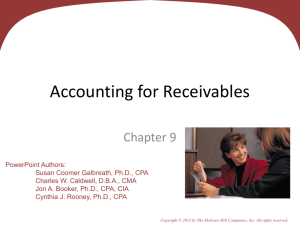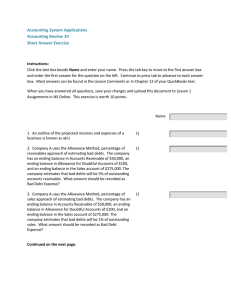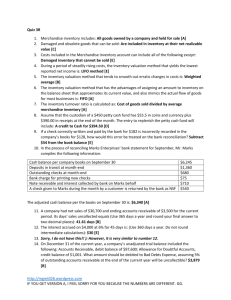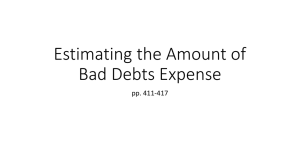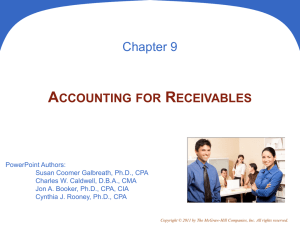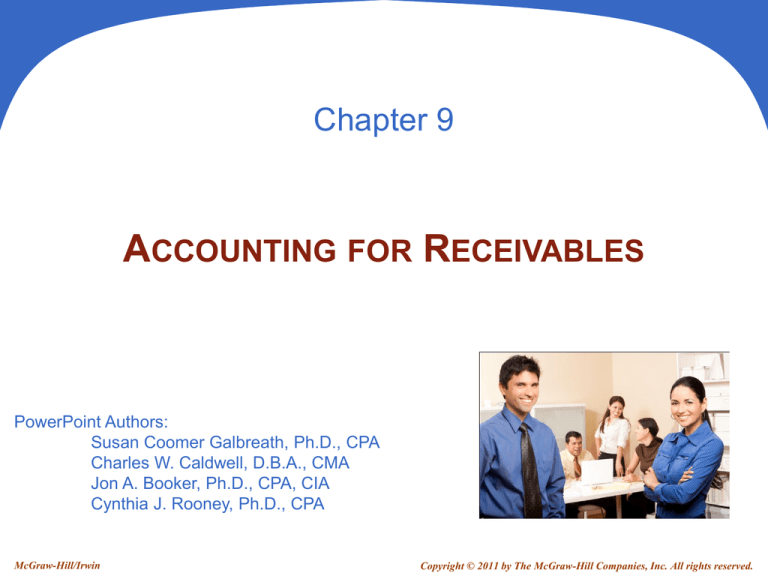
Chapter 9
ACCOUNTING FOR RECEIVABLES
PowerPoint Authors:
Susan Coomer Galbreath, Ph.D., CPA
Charles W. Caldwell, D.B.A., CMA
Jon A. Booker, Ph.D., CPA, CIA
Cynthia J. Rooney, Ph.D., CPA
McGraw-Hill/Irwin
Copyright © 2011 by The McGraw-Hill Companies, Inc. All rights reserved.
9- 2
C1
SALES ON CREDIT
On July 1, TechCom had a credit sale of $950 to
CompStore and a collection of $720 from RDA
Electronics from a prior credit sale.
9- 3
C1
SALES ON CREDIT
9- 4
C1
CREDIT CARD SALES
Advantages of allowing customers to use
credit cards:
Customers’
credit is
evaluated by
the credit card
issuer.
Sales increase by
providing purchase
options to the customer.
The risks of extending credit
are transferred to the credit
card issuer.
Cash collections
are quicker.
9- 5
P1
VALUING ACCOUNTS RECEIVABLE
Some customers may not pay their account.
Uncollectible amounts are referred to as bad debts.
There are two methods of
accounting for bad debts:
Direct Write-Off Method
Allowance Method
9- 6
P1
MATCHING VS. MATERIALITY
The matching
(expense recognition)
principle requires
expenses to be
reported in the same
accounting period as
the sales they helped
produce.
Materiality states that
an amount can be
ignored if its effect on
the financial
statements is
unimportant to users’
business decisions.
The direct write-off method usually does not best
match sales and expenses.
9- 7
P1
ALLOWANCE METHOD
At the end of each
period, estimate total bad
debts expected to be
realized from that
period’s sales.
1.
2.
Two advantages to the allowance method:
It records estimated bad debts expense in the period
when the related sales are recorded.
It reports accounts receivable on the balance sheet
at the estimated amount of cash to be collected.
9- 8
P1
RECORDING BAD DEBTS EXPENSE
TechCom had credit sales of $300,000 during its first year of
operations. At the end of the first year, $20,000 of credit
sales remained uncollected. Based on the experience of
similar businesses, TechCom estimated that $1,500 of its
accounts receivable would be uncollectible.
9- 9
P1
BALANCE SHEET PRESENTATION
TechCom had credit sales of $300,000 during its first year of
operations. At the end of the first year, $20,000 of credit
sales remained uncollected. Based on the experience of
similar businesses, TechCom estimated that $1,500 of its
accounts receivable would be uncollectible.
9- 10
P1
WRITING OFF A BAD DEBT
TechCom decides that J. Kent’s $520 account is
uncollectible.
9- 11
P1
WRITING OFF A BAD DEBT
The write-off does not affect the realizable
value of accounts receivable.
9- 12
P1
RECOVERING A BAD DEBT
To help restore credit standing, a customer sometimes
volunteers to pay all or part of the amount owed on an
account even after it has been written off.
On March 11, Kent pays in full his $520 account
previously written off.
9- 13
P2
ESTIMATING BAD DEBTS EXPENSE
Two Methods
1. Percent of Sales Method
2. Accounts Receivable Methods
Percent of Accounts Receivable
Aging of Accounts Receivable
9- 14
P2
PERCENT OF SALES METHOD
Bad debts expense is computed as follows:
Current Period Sales
×
Bad Debt %
= Estimated Bad Debts Expense
9- 15
P2
PERCENT OF RECEIVABLES METHOD
1. Compute the estimate of the Allowance
for Doubtful Accounts.
Year-end Accounts Receivable
× Bad Debt %
2. Bad Debts Expense is computed as:
Total Estimated Bad Debts Expense
– Previous Balance in Allowance Account
= Current Bad Debts Expense
9- 16
P2
AGING OF RECEIVABLES METHOD
Classify each receivable by how
long it is past due.
Each age group is multiplied by its
estimated bad debts percentage.
Estimated bad debts for each group
are totaled.
9- 17
P2
AGING OF ACCOUNTS RECEIVABLE
9- 18
C2
NOTES RECEIVABLE
A promissory note is a written promise to pay a specified
amount of money, usually with interest, either on
demand or at a definite future date.
9- 19
C2
INTEREST COMPUTATION
Even for
maturities less
than one year,
the rate is
annualized.
If the note is
expressed in
days, base a
year on 360
days.
9- 20
END OF CHAPTER 9


